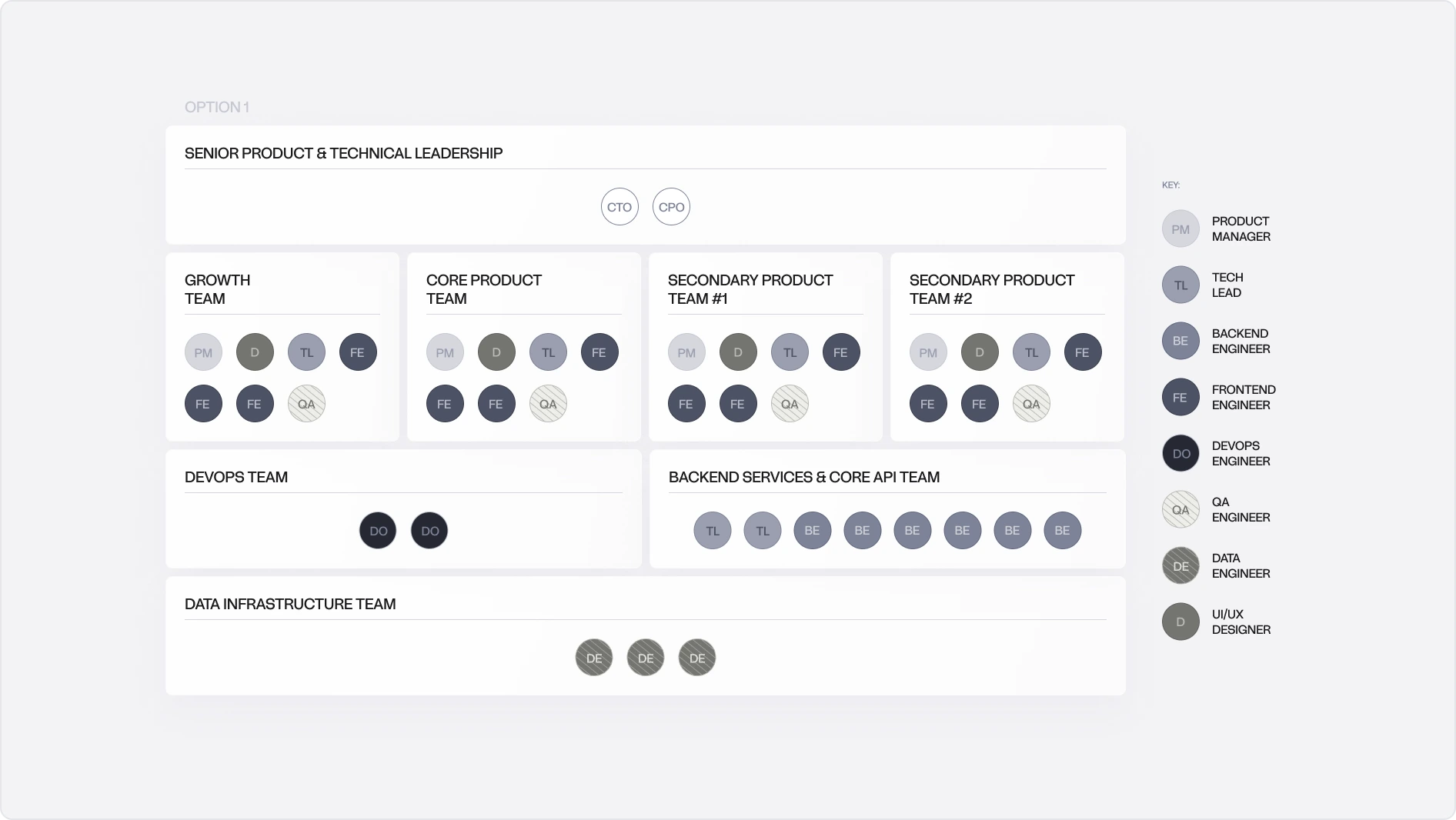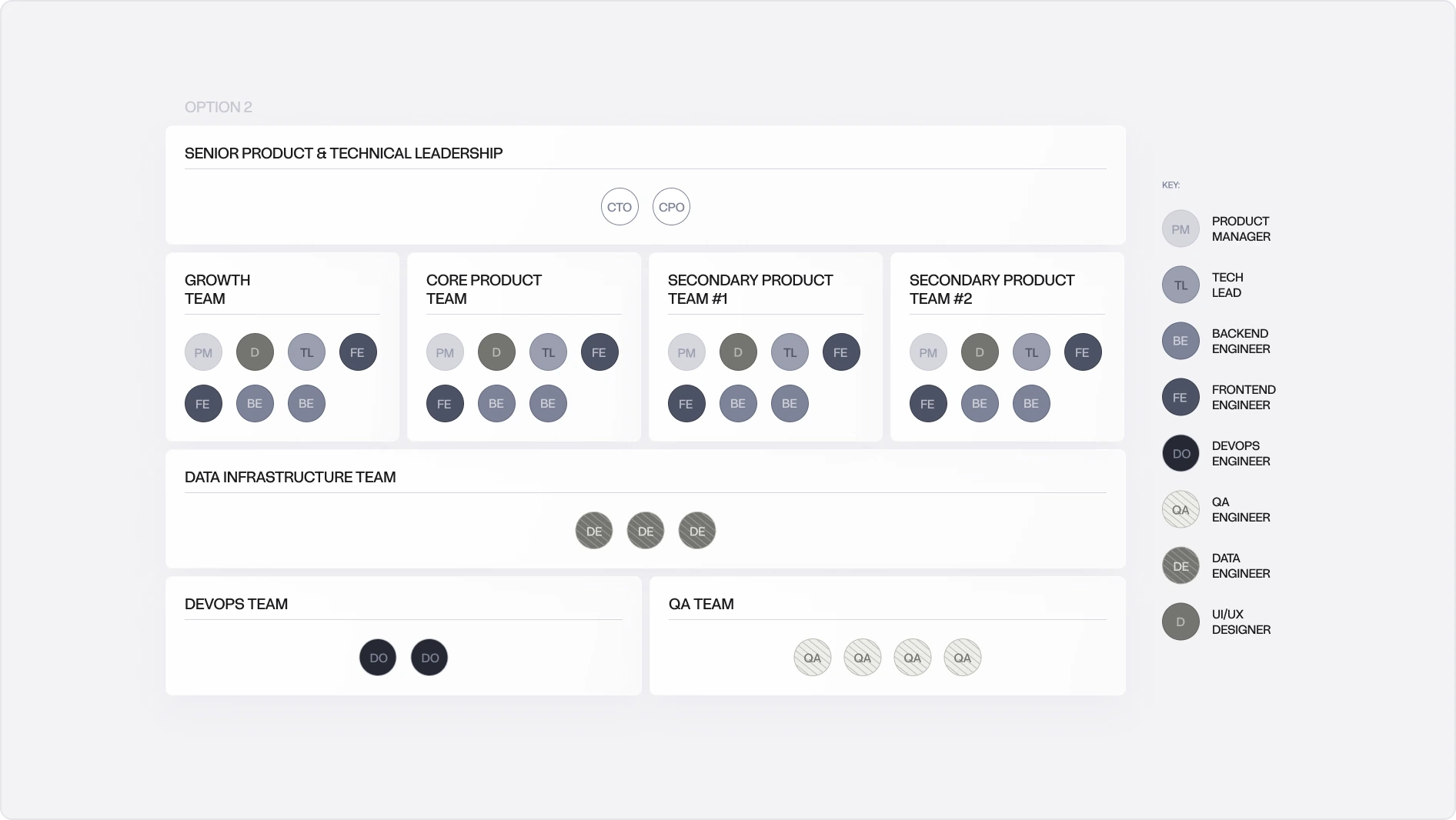From Monoliths to Modular: How to Structure Engineering Teams as You Scale

From Monoliths to Modular: How to Structure Engineering Teams as You Scale
Scaling tech companies often hit bottlenecks as old engineering structures slow progress. This guide covers when to restructure, proven team models, and key principles to scale effectively.
After working closely with many fast-growing tech companies, I’ve noticed a common turning point: product development starts to slow down, not because the team is underperforming, but because the engineering structure no longer fits the company’s size. Too many meetings, too many bottlenecks, and progress stalls. The team isn’t broken, it’s just outgrown the way it was originally set up.
This is the stage where CTOs start asking:
“How can we restructure our engineering team to keep scaling without slowing down?”
In this guide, you’ll learn:
- When and why to restructure your teams
- Proven team structures that support scaling
- A real-world case study from one of our Series B clients
- Key principles for a smooth transition
- How to not lose your leaders during the transition
1. The Hidden Bottleneck:
When to Restructure Your Engineering Org
If you’re seeing signs like these, it’s time to rethink your team structure:
- Too many high-priority initiatives for one team to handle
- Deadlines are consistently missed
- Cycle times are increasing despite more engineers
- Ownership is unclear across teams
- Misalignment between product, design, and engineering
- Low morale or higher attrition due to a lack of direction
A good litmus test:
If adding headcount makes your team slower, not faster, your org needs to evolve.
2. Team Structures That Work for Scaleups
(With Tradeoffs)
There’s no perfect team structure. But the right one depends on your product complexity, system architecture, and team maturity. These are the three most effective models we’ve seen at high-growth startups.
1. Cross-Functional Product Teams
What it is:
Small, autonomous teams aligned to specific product areas or customer outcomes. Each team includes a product manager, frontend/backend engineers, QA, and often a UI/UX designer.
Example:
- Growth Team - owns onboarding, activation, and referral flows
- Core Product Team - owns your primary service or feature set
- Secondary Product Teams - own supporting product modules (such as Payments & Billing - which enable and extend core product functionality)

When it works:
✅ Your product serves different user personas or feature sets
✅ You need fast delivery cycles and feedback loops
✅ You want to empower PMs and Tech Leads to drive outcomes
Benefits:
- Clear ownership of product areas
- Faster decision-making
- Teams can scale independently
Watch out for:
- Inconsistent engineering standards across teams
- Architectural drift without centralized alignment
- PMs being stretched too thin (if spread across multiple teams)
Tip: Establish off-team engineering leadership (e.g., an architect or platform lead) to maintain consistency in tooling, standards, and infrastructure.
2. Domain-Aligned or Layered Teams
What it is:
Teams are organized around technical layers rather than product verticals. For example:
- Frontend
- Backend Services & APIs
- Data Engineering
- QA/Automation

When it works:
✅ Your product is relatively simple or tightly scoped
✅ You’ve adopted a service-oriented or modular monolith architecture
✅ Frontend/backend work is largely decoupled
Benefits:
- Deep specialization
- Better focus on reliability and scalability
- Clear domains for hiring and onboarding
Watch out for:
- Slower product delivery due to cross-team dependencies
- Backend teams becoming bottlenecks
- Technical debt accumulating if product feature pressure dominates
Tip: Ensure each domain team includes someone who can weigh business impact against technical priorities.
3. Hybrid Teams
What it is:
A combination of cross-functional product teams focused on user-facing features and domain teams that provide shared infrastructure, services, and APIs. We’ve seen this model being most popular with startups that have larger teams.
Example Setup:
- 3 Product Teams (Growth, Core Offering, Secondary Offering)
- 2 Domain Teams (Backend Services, Data Infrastructure)


When it works:
✅ You’ve outgrown a single-team model
✅ You want to balance speed with architectural consistency
✅ You have strong leads to manage both product and domain scopes
Benefits:
- Fast iteration on the product side
- Scalable infrastructure owned by specialists
- Clear interfaces between product and domain teams
Watch out for:
- Domain teams becoming bottlenecks
- Tension between shipping quickly and building sustainably
- Critical architecture decisions isolated to too few people
Tip: Domain teams should operate with a customer mindset measuring success by the velocity and impact of product teams.
3. A Case Study From a Domain-Aligned to a Hybrid Topology
One of our Series B SaaS clients at OAK’S LAB grew from 12 to 40 engineers in just 9 months. Initially, they operated using a domain-aligned structure with separate frontend and backend teams.
⚠️ The problem:
- The product became too complex for a single frontend team
- The backend team created bottlenecks for feature delivery
- PMs were having trouble balancing conflicting priorities
✅ The solution:
We guided a transition to three cross-functional product teams that included frontend and backend engineers, while refocusing the backend team into a domain team owning architecture, database, and API strategy.
Each product team had a PM and Tech Lead with full ownership of a product area. We embedded a dedicated OAK’S LAB product team to accelerate delivery and stabilize the shift. We also led the creation of a “North Star” value proposition and product roadmap, aligned across the CEO, all key departments, and all product teams.
✨ Results in 90 days:
- 35% increase in individual engineering velocity
- 2× faster onboarding of new engineers
- We delivered every milestone in the roadmap on time
- And most importantly, we delivered features that were most impactful to the business
4. Restructure With Confidence: Points of Advice
1. Over-Communicate During the Transition
Change breeds ambiguity. Visualize the new org for everyone to see.
2. Assign Ownership, Not Just Headcount
Be explicit about responsibilities, decision rights, escalation paths, and success outcomes for each team to aim for.
3. Promote Context Over Control
Equip team leads with business context so they can own outcomes, not just tasks.
4. Stabilize Culture Through Shared Rituals
Preserve alignment and learning through weekly demos, engineering guilds, and joint planning.
5. Revisit Structure Every 6-12 Months
The org design isn’t one-and-done. Reevaluate every 6-12 months as your team and product evolve.
5. Don’t Lose Your Leaders
Usually, having top-quality team leads can compensate for a poorly designed team structure. And, one of the most overlooked risks during restructuring? Burning out or losing your best people. Here’s how to mitigate that:
- Include your leads in the planning process
- Make sure that the new setup doesn’t stretch them too thin
- Give more responsibilities to senior ICs
- Don’t promote people into leads without support
- Pair new leads with coaches within the org
- Clarify how performance will be evaluated in the new structure
Final Thought.
You Don’t Just Scale by Hiring,
You Scale by Dividing Well.
You can’t scale culture passively. It has to be designed, just like your software architecture. Team growth without structure leads to chaos and inefficiency. A structure without an ambitious culture tends to lead to bureaucracy. The best engineering teams design their org structure as deliberately as their product.
Where OAK’S LAB Fits In
We help tech companies restructure and embed ready-to-ship software development teams that:
- Take full ownership of a product area or technical domain
- Integrate seamlessly into your organizational setup
- Coach internal leads to build a high-performing, sustainable culture
From product to domain, our goal is to always be the highest-performing team in our clients’ product organization.
.webp)






